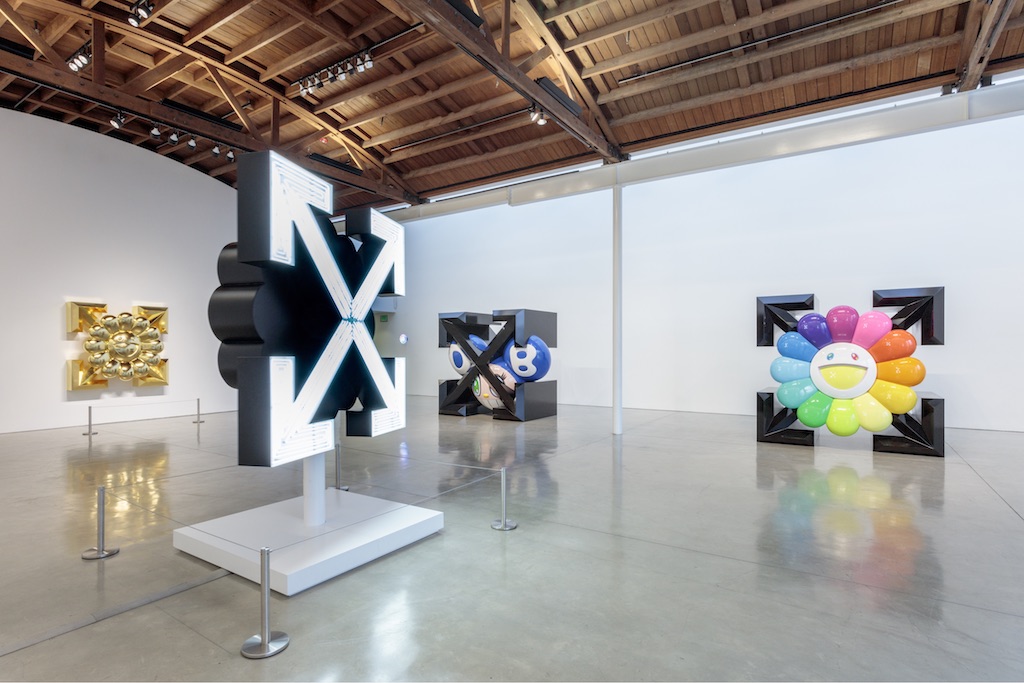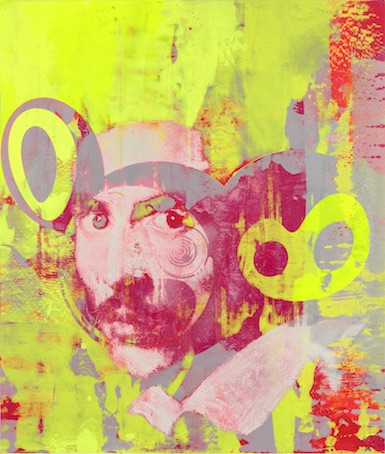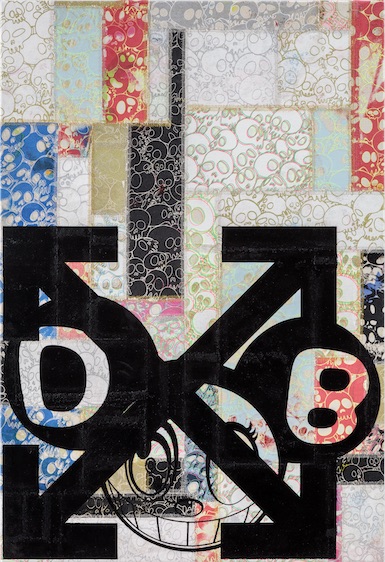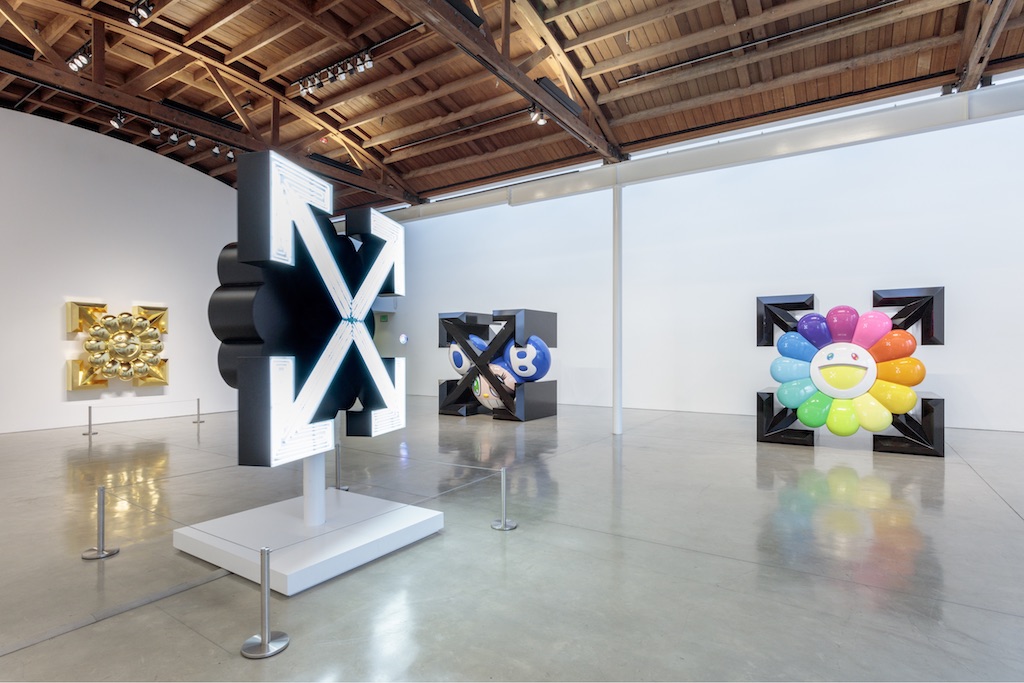[ad_1]

Installation view of “Murakami & Abloh: AMERICA TOO,” 2018, at Gagosian, Los Angeles.
©VIRGIL ABLOH AND TAKASHI MURAKAMI/PHOTO: JOSHUA WHITE—JWPICTURES.COM/COURTESY GAGOSIAN
In the past few years, artists and fashion designers have been working together so frequently, there’s now a phrase to describe their projects together: “collab culture.” In the early 2000s, Marilyn Minter and KAWS worked together to create their own respective collaborative collections for the streetwear brand Supreme. At that time, it surprised some, but today, it would hardly turn any heads. Over the past year, Cindy Sherman, Nan Goldin, and the estate of the late Mike Kelley all worked on pieces with Supreme. Eckhaus Latta had a solo show at the Whitney Museum in New York, Dior Homme commissioned KAWS to create a version of his trademark character for its spring/summer 2019 collection, and Balenciaga brought in digital artist Jon Rafman to make the runway for its spring/summer 2019 show in New York this past September.
Louis Vuitton men’s wear artistic director Virgil Abloh and artist Takashi Murakami are two of the major movers in the “collab culture” movement, and—you guessed it—now they’re collabing, too. Having worked together several times in the past, Abloh and Murakami have now produced “AMERICA TOO,” a show featuring 35 works created by the two, which is on display at Gagosian gallery’s Beverly Hills outpost through October 25.

Takashi Murakami & Virgil Abloh, Yellow and Pink, 2018, acrylic on canvas mounted on aluminum frame.
©VIRGIL ABLOH AND TAKASHI MURAKAMI/PHOTO: JOSHUA WHITE—JWPICTURES.COM/COURTESY GAGOSIAN
In an interview with the artists following the opening of the show, Abloh spoke about the value of working together to produce art. “I like that collaborating is evidence of being human,” he told ARTnews. “This is what happens when you join two people that are similar but very different. Our works of art are born from that dialogue.”
This isn’t the first time Murakami and Abloh have collabbed—far from it, in fact. This year alone, they have done three shows with Gagosian. They’ve known each other for over ten years, and they first met through Kanye West. (Around the time Murakami illustrated the cover art for West’s 2007 album Graduation, Abloh served as the rapper’s art director.) Abloh recalled being a fan of Murakami’s work before they met, and has cited him as an inspiration during his rise to fame, as the founder of the Italian fashion brand Off-White. Since then, Murakami has called Abloh an inspiration as well.
Murakami was the one who invited Abloh to start the collaboration. “Thanks to him, my perception of the fashion scene has greatly expanded,” Murakami said. “At first glance, his first LV runway show was an accessible homage to high fashion and street fashion of the past 20 years, but at the same time, it represented a strategic move toward a complete transformation of fashion. Whereas fashion used to be about appearance, texture, and wearability, he has made it conceptual.”
Their joint efforts have proven fruitful. The rapper Drake was a recent buyer of a piece by the duo—a larger-than-life sculpture of Murakami’s signature beaming flower atop the logo for Abloh’s Off-White, rendered in shining black plastic.

Takashi Murakami & Virgil Abloh, DOB and Arrows: Patchwork Skulls, 2018, acrylic on canvas mounted on aluminum frame.
©VIRGIL ABLOH AND TAKASHI MURAKAMI/PHOTO: JOSHUA WHITE—JWPICTURES.COM/COURTESY GAGOSIAN
For Abloh, the Gagosian show brought out aspects of his and Murakami’s practice that aren’t readily visible in the artists’ solo work. “In art or design,” he said, “there are things that are achieved through collaboration that don’t exist in each person’s practice.”
Aesthetically speaking, their Gagosian show represents a literal merger of their interests. Many of the paintings in the exhibition collage the two artists’ trademarks images— like Murakami’s alter ego, Mr. DOB, a smiley anime-influenced head with round ears and big eyes, and Abloh’s Off-White sign, two arrows crossing one another—next to or above one another. Their sensibilities are, in some sense, at odds with one another. Abloh opts for minimalism and starkness in his clothing, Murakami for extravagance and playfulness in his installations—but in the Gagosian show, they create a beautiful combination of sensibilities. Abloh estimates that their respective trademark symbols embody “a lifelong investigation in one gesture.” Call it a power clash.
Murakami said that he is interested in the works on a formal level. He brought up Yellow and Pink, a painting in which an image borrowed from the Bernini painting Self-Portrait of a Small Man melts into a candy-colored graffiti canvas, his face fading behind the silhouette of Mr. DOB’s cartoonish head and ears. Other sculptures in the show (including the one that Drake purchased) are variations on similar subject matter. Overlaid and seen in repetition, the petals of Murakami’s flower and the spokes of Abloh’s arrows appear to be in dialogue with one another.
Though the Gagosian show closes on Thursday, Abloh and Murakami already have another project in the pipeline—a show of prints by the two set to open at Tokyo’s Oz Zingaro gallery this weekend. The Oz Zingaro show will feature several new pieces that riff on the look of street graffiti, as well as works similar to those currently on view at Gagosian.
They are collaborating at almost a ludicrous rate, and Abloh said it’s because they value each other’s dialogue. For him, this is partly a project about breaking down the boundaries between art and fashion. (Such divisions will continue to erode in a Museum of Contemporary Art, Chicago retrospective for Abloh this summer.) He said that he considers dialogue an important part of his work, allowing him to think about ideas relevant to our current moment. “Conversation,” he said, “is a way to communicate, and when ideas are born [out of it], they’re the most relevant.”
[ad_2]
Source link

